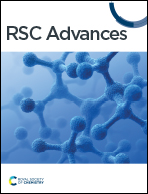Electron-donating arene-substituted pentacenedione derivatives: a study of structural, electronic, and electrochemical properties†
Abstract
A new series of redox-active tetraryl-substituted pentacenedione derivatives, namely Ar4-PDs, was prepared through Suzuki–Miyaura coupling reactions between a bis(dibromomethane)pentacenedione and various arene boronic acids. Single-crystal X-ray diffraction analysis and density functional theory (DFT) calculations have confirmed that these Ar4-PDs possess highly twisted conformations due to the significant steric encumbrance between the Ar substituents and the anthraquinodimethane moiety. Cyclic voltammetric analysis revealed that the nature of the Ar group critically influences the redox properties of Ar4-PDs. In the case where the Ar group is a strong electron donor, triphenylamino (TPA), the Ar4-PD derivative exhibits an amphoteric redox behavior with a narrowed electrochemical band gap (1.38 eV) and a noticeable intramolecular charge transfer (ICT) band in the visible region of the spectrum. The twisted molecular conformation is believed to facilitate through-space interactions between the donor (TPA) and acceptor (anthraquinone) groups, while protonation of this compound with a strong organic acid can further enhance the ICT effect.



 Please wait while we load your content...
Please wait while we load your content...